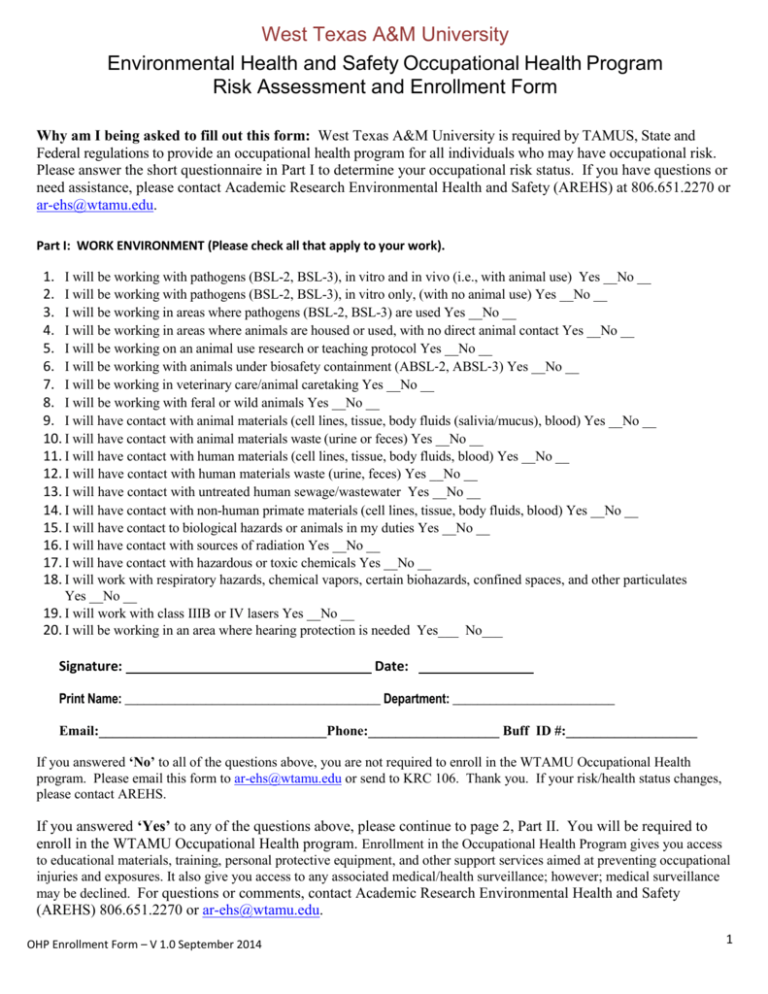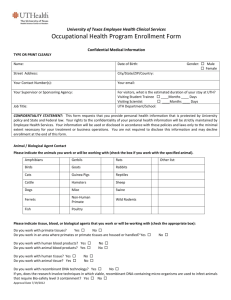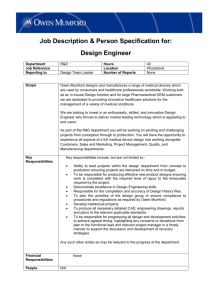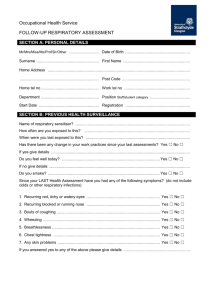Risk Assessment and Enrollment Form
advertisement

West Texas A&M University Environmental Health and Safety Occupational Health Program Risk Assessment and Enrollment Form Why am I being asked to fill out this form: West Texas A&M University is required by TAMUS, State and Federal regulations to provide an occupational health program for all individuals who may have occupational risk. Please answer the short questionnaire in Part I to determine your occupational risk status. If you have questions or need assistance, please contact Academic Research Environmental Health and Safety (AREHS) at 806.651.2270 or ar-ehs@wtamu.edu. Part I: WORK ENVIRONMENT (Please check all that apply to your work). 1. I will be working with pathogens (BSL-2, BSL-3), in vitro and in vivo (i.e., with animal use) Yes __No __ 2. I will be working with pathogens (BSL-2, BSL-3), in vitro only, (with no animal use) Yes __No __ 3. I will be working in areas where pathogens (BSL-2, BSL-3) are used Yes __No __ 4. I will be working in areas where animals are housed or used, with no direct animal contact Yes __No __ 5. I will be working on an animal use research or teaching protocol Yes __No __ 6. I will be working with animals under biosafety containment (ABSL‐2, ABSL‐3) Yes __No __ 7. I will be working in veterinary care/animal caretaking Yes __No __ 8. I will be working with feral or wild animals Yes __No __ 9. I will have contact with animal materials (cell lines, tissue, body fluids (salivia/mucus), blood) Yes __No __ 10. I will have contact with animal materials waste (urine or feces) Yes __No __ 11. I will have contact with human materials (cell lines, tissue, body fluids, blood) Yes __No __ 12. I will have contact with human materials waste (urine, feces) Yes __No __ 13. I will have contact with untreated human sewage/wastewater Yes __No __ 14. I will have contact with non-human primate materials (cell lines, tissue, body fluids, blood) Yes __No __ 15. I will have contact to biological hazards or animals in my duties Yes __No __ 16. I will have contact with sources of radiation Yes __No __ 17. I will have contact with hazardous or toxic chemicals Yes __No __ 18. I will work with respiratory hazards, chemical vapors, certain biohazards, confined spaces, and other particulates Yes __No __ 19. I will work with class IIIB or IV lasers Yes __No __ 20. I will be working in an area where hearing protection is needed Yes___ No___ Signature: Date: Print Name: _________________________________________ Department: __________________________ Email:_________________________________Phone:___________________ Buff ID #:___________________ If you answered ‘No’ to all of the questions above, you are not required to enroll in the WTAMU Occupational Health program. Please email this form to ar-ehs@wtamu.edu or send to KRC 106. Thank you. If your risk/health status changes, please contact AREHS. If you answered ‘Yes’ to any of the questions above, please continue to page 2, Part II. You will be required to enroll in the WTAMU Occupational Health program. Enrollment in the Occupational Health Program gives you access to educational materials, training, personal protective equipment, and other support services aimed at preventing occupational injuries and exposures. It also give you access to any associated medical/health surveillance; however; medical surveillance may be declined. For questions or comments, contact Academic Research Environmental Health and Safety (AREHS) 806.651.2270 or ar-ehs@wtamu.edu. OHP Enrollment Form – V 1.0 September 2014 1 Part II: Continue only if you answered ‘yes’ to any of the questions in Part I. We need to collect a few more details related to your occupational exposures related to pathogens and animals. PATHOGENS Exposures: NIH Risk Group Classifications Factors that determine the specific risk group classification for infectious agents include the following: pathogenicity of the organism mode of transmission and host range availability of effective preventive measures (for example, vaccines) availability of effective treatments (for example, antibiotics) NIH Basis for the Classification of Biohazardous Agents by Risk Group (RG) Risk Group 1 (RG1) Agents that are not associated with disease in healthy adult humans. Risk Group 2 (RG2) Agents that are associated with human disease which is rarely serious and for which preventive or therapeutic interventions are often available. Risk Group 3 (RG3) Agents that are associated with serious or lethal human disease for which preventive or therapeutic interventions may be available (high individual risk but low community risk). Risk Group 4 (RG4) Agents that are likely to cause serious or lethal human disease for which preventive or therapeutic interventions are not usually available (high individual risk and high community risk). You may also refer to Appendix B of the NIH Guidelines for Research Involving Recombinant DNA Molecules for a current list of microorganisms in each risk group. This resource can be found on: http://osp.od.nih.gov/sites/default/files/NIH_Guidelines_0.pdf Please answer the following: 1. I am not listed on a research protocol but I work in an area where Risk Group 3 agents are directly handled, or where animals potentially infected with RG 3 agents are located. Yes __No __ 2. I am not listed on a research protocol but I work in an area where Risk Group 2 agents are directly handled, or where animals potentially infected with RG2 agents are located. Yes __No __ Please list any Institutional Biosafety (IBC) or Institutional Animal Care and Usage (IACUC) protocols in which you participate: Or, check the following: I do not participate in any IBC or IACUC protocols _________________. IBC/IACUC Protocol # Principal Investigator OHP Enrollment Form – V 1.0 September 2014 Department 2 3. I am only handling diagnostic laboratory samples which are potentially infected with Risk Group 2 and/or 3 agents. Yes __No __ ANIMAL Exposures: 4. Animal Handling: 4.1. I directly handle animals. Yes __No __ 4.2. I work in areas where animals are housed, handled or treated, but I do not directly handle animals. Yes __No __ Please complete the following table: Mark the box (X) of each species for which the statement is correct ►►► Animals▼▼▼ Laboratory Mice Laboratory Rats Laboratory Guinea Pigs Laboratory Hamsters Rabbits Monodelphis domesticus Domestic Dogs Domestic Cats Ferrets Bats Horses Cattle Sheep Goats Deer Swine Poultry/Turkey Birds Reptiles Amphibians Fish Non-Human Primate-specify Wild Capture–Target Species Wild Capture–Target Species Other - Specify OHP Enrollment Form – V 1.0 September 2014 I DIRECTLY HANDLE these animals as part of job duties I DIRECTLY HANDLE tissues or wastes from these animals as part of job duties (MARK▼) (MARK▼) I DO NOT DIRECTLY HANDLE animals; but, I work where animals are housed, handled or treated (MARK▼) 3 5. Please give a description of specific job duties which brings you into contact with animals/biohazards: (Include details such as use of personal protective equipment; environmental conditions, e.g., indoors or outdoors; frequency of handling; duration of handling; and numbers of animals. Add additional job duties on a separate piece of paper.) Part III: Participation in medical/health surveillance activities Now that we have your occupational exposure information –you have a choice. AREHS will conduct an initial base-line evaluation of potential exposure risk using this form. In many cases, training or use of personal protective equipment, or environmental controls will likely be all that is required and will have already been implemented in most of our occupational risk areas, i.e., 24.01.01.W1.33AR Chemical Hygiene Plan, 24.01.01.W1.20AR WTAMU Radiation Safety Procedures, 24.01.01.W1.39AR WTAMU Laser Safety Procedures, 24.01.01.W1.15AR Bloodborne Pathogen Exposure Control Plan, and 24.01.01.W1.17AR WTAMU Mobile and Heavy Equipment Management Procedure. These Standard Operating Procedures can be located at www.wtamu.edu/arehs. Based on OHP standards, specific preventive measures which may include immunizations, additional medical tests, or health monitoring may be recommended. For example, if you are working with bats, the rabies immunoprophylaxis vaccination will be recommended. Please note: AREHS does not make medical assessments or recommendations. Medical assessments or recommendations are conducted through a university approved occupational health provider. You may decline medical/health surveillance activities. Declining medical/health surveillance participation gives you access to educational materials, training, personal protective equipment, and other support services aimed at preventing occupational injuries and exposures; however; no medical surveillance will be offered. In certain cases, if you decline to participate, you may be denied access to certain facilities or prohibited from certain activities, such as in the case of BSL 2 (or higher) laboratories. If you are an employee, accepting participation gives you access to appropriate occupational medical surveillance/services at no cost to you, as well as all educational materials, training, personal protective equipment, and other support services aimed at preventing occupational injuries and exposures. Based on your completion of this OHP Risk Assessment and Enrollment Form, please check one of the following and sign: _____I decline medical surveillance services: please sign: _____I accept medical surveillance services: please sign: If you are declining medical surveillance, you have now completed the OHP Risk Assessment and Enrollment Form. Please email this form to ar-ehs@wtamu.edu or bring /campus mail to KRC 106. Thank you. If your risk/health status changes or you decide you want to accept medical surveillance services, please contact AREHS. Part IV: If you have accepted medical surveillance services, please complete Part IV I. IMMUNIZATIONS Have you ever received the following: Tetanus Vaccination Rabies Vaccinations (series of 3) Hepatitis A Vaccinations (series of 2) OHP Enrollment Form – V 1.0 September 2014 Received (Yes/No/Unknown) Year Received 4 Hepatitis B Vaccinations (series of 3) II. IMMUNE STATUS Yes or No 1. Have you been diagnosed with a condition that weakens your immune system? 2. Do you currently take any medication that weakens your immune system? 3. Have you been diagnosed with a valvular or congenital heart condition? 4. Have you ever changed jobs/work habits due to health issues from animal exposure? III. ASTHMA/ALLERGIES Yes or No 1. Do you have asthma? I consider my Asthma to be: Mild Moderate Severe 2. Is your asthma specifically related to animals? 3. Do you have animal allergies (i.e., sneezing, wheezing, itchy eyes, hives)? I consider my animal allergies to be: Mild Moderate Severe Moderate Severe 4. Do you have other allergies (i.e., latex or chemical allergies)? I consider my other allergies to be: Mild 5. Do you currently take medication for asthma or allergies? 6. Do you have contact with pets, livestock, or wildlife outside of work hours? 7. Did you work with animals before your employment with this facility? IV. ADDITIONAL HEALTH CONCERNS 1. Do you have any workplace health concerns you want to discuss with an Occupational Medicine provider? Yes No Thank you! You have now completed the OHP Risk Assessment and Enrollment Form. Please email this form to arehs@wtamu.edu or bring/campus mail to KRC 106. Thank you. If your risk/health status changes or you decide you want to accept medical surveillance services, please contact AREHS. For questions, comments or concerns, please contact: Occupational Health Program Environmental Health and Safety Program West Texas A & M University WT Box 60217 Canyon, TX 79016 Ar-ehs@wtamu.edu 806.651.2270/Fax 806.651.2733 KRC 106 OHP Enrollment Form – V 1.0 September 2014 5




